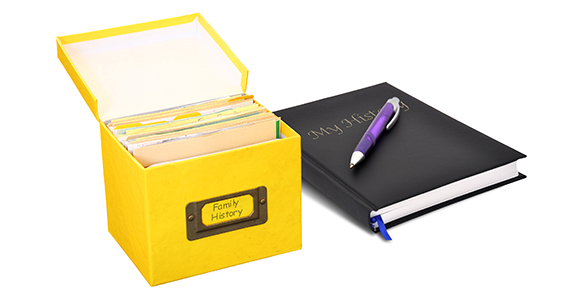How to Get Started Writing a Personal History
Contributed By Marianne Holman Prescott, Church News staff writer

Using an old recipe box can be a great way to organize family history. Writing your personal history is important for future generations to know who you are.
Article Highlights
- Everyone has stories to tell.
- When writing a personal record, write as if you are talking to someone.
- Use interesting, descriptive, sensitive words to bring readers into the story and help them make a connection.
“Everyone has something they can share. I’m not famous. I don’t have anything that would be newsworthy, but I have stories.” —Tafta Johnson Watson
Related Links
For many, starting to write a personal history can seem overwhelming. Many people feel they haven’t done anything extraordinary in their life that others would want to hear about, and the thought of piecing everything together can be intimidating.
“Everyone has something they can share,” said Tafta Johnson Watson during the BYU Conference on Family History and Genealogy on July 28. “I’m not famous. I don’t have anything that would be newsworthy, but I have stories.”
During a presentation titled “Writing Your Story,” Sister Watson shared ideas of how to get started and compile a personal family history. She began with a story her grandchildren always like hearing about—a tomato fight with her brothers when she was a little girl.
Often, favorite family stories are great starting-off points for compiling a personal history. Sometimes, the beginning starts with simply thinking of a story or event from an individual’s life.
“Don’t think of the whole finished product,” Sister Watson said. “As you write, ideas will come.”
In recording a personal history, it is important to “write as if you are talking to someone,” she said. By doing so, readers will feel more connected to the story, and, in turn, their family.
In an effort to keep things organized, Sister Watson shared hints such as using a box or file folder that holds cards with different titles on them, a loose-leaf binder, a notebook, an app for a phone or tablet that allows individuals to record notes as they are on the go, or a working document saved to their computer that they can continually add ideas to and edit. Photos can be saved along with the titles to accompany the history.
“If you think of a story, write down a title that will help you remember it,” she said. “And then divide your life into periods or sections. Choose sections that best match your ideas and stories.”
Recognizing there is not one right way to divide things up, Sister Watson shared suggestions to help listeners organize their life. Sections based on their age or time frame of life make it easy to categorize things in a general time frame, especially when exact dates or ages are not known.
By putting things in a chronological order, individuals are able to keep things organized in a logical, systematic way. Those sections might include birth to school, elementary school years, middle school years, high school years, college, mission, courtship, family, career, and so on. Another idea would be to organize things by category.
“Good writing starts with a plan or an outline,” she said.
After individuals have ideas of at least a few stories they want to tell, they can look at one of the titles they have saved and start writing from there.
Most important, Sister Watson said, is to “just start writing.”
Sometimes photos can spark an idea, as well as thinking of important dates and events. It is important to take it a piece at a time, she said.
“But what do I write about?” she asked. “Everyday things, ‘ah-ha’ moments, spiritual experiences or special events, fun times, learning moments. You can teach lessons or share your values.”
It is important to remember who will be reading the history you write—if it is just for family, important spiritual events may be important to include. If it is a public record, it is important to be wise in choosing what will be included in the history.
“As ideas come, jot them down,” she said.
Sharing ideas she used as a teacher at Fillmore Middle School, Sister Watson said to consider the setting and where the story took place. Using interesting, descriptive, sensitive words brings the readers into the story and helps them to make a connection. Important to an individual’s family history are the friends, family, co-workers, and others with whom they’ve had relationships.
As authors compile the stories and photos, they will be able to piece together a personal history.
One hint Sister Watson shared was to find a “trusted partner” who is willing to read what they have written before distributing the personal history. Sometimes it is difficult for the author to see spelling or grammatical errors, and someone with an outside view can give suggestions. Then, as the author shares the history with others, it will be more readable.
Family history is an important work that helps not only the person creating his or her own story but also his or her family and generations to come, she said.
